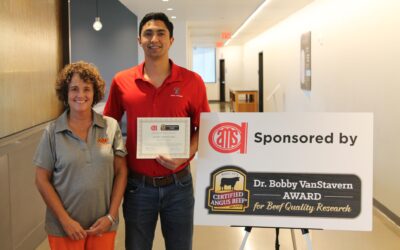
Bending Curves, Breaking Stereotypes
by Miranda Reiman
Angus cattle need to do more than ever before. Carcass quality, functional females, feedlot performance—they all matter.
That theme was evident at the Innovation Workshops during the National Angus Convention, Nov. 4 to 7, in Indianapolis, Ind.
John Stika, president for the Certified Angus Beef ® (CAB®) brand, talked of reaching the billion-pound sales milestone in the recent fiscal year.
“You won’t find a bigger fan of marbling than me, but the success of CAB is more than just marbling,” he said.
It starts with a live, healthy calf and all the ranch-level money-makers, Stika said.
He recalled a producer once telling him about a high-quality carcass: “It’s the most valuable thing we produce, but it’s the last thing we get paid for.”
That’s why it’s important to be sure cattle are “doing it all,” Stika said, while challenging the crowd to further
the breed’s current momentum.
“We will not sell two billion pounds of Certified Angus Beef doing the exact same thing we did for the last 38 years,” he said.
Employing all available technology is the logical path.
“The genomics will just become part of what we do. It won’t be special anymore,” Stephen Miller, director of genetic research for the American Angus Association, predicted.

In 2015, a quarter of all registered Angus cattle included DNA information.
That data helps make expected progeny differences (EPDs) more accurate.
Miller told the audiences how to use those measures to make progress while avoiding narrow selection.
“The more traits we throw at the thing, the less progress you’re going to make in any one of them,” he said, noting that’s why indexes were created.
The scientist suggested using economically weighted values, such as weaned calf value ($W) or beef value ($B), to rank animals.
“Then we can look at different traits and structure and things like that,” he said.
Trends show cattlemen are making progress, as the breed average for $B, carcass weights and marbling have trended up. At the same time, weaning weight has improved, while birthweight has decreased.
“Curve benders” have become more common, said Dan Shike, University of Illinois animal scientist.
“It used to be if you selected a calving-ease bull, you just had to accept that you were giving up other traits,” he said.
Curve benders are typically considered those with “relatively low birthweight as compared to weaning weight,” Kent Andersen, director of genetic technical services for Zoetis, explained.
He and Shike evaluated live animals and then revealed their genomic data, talking through how it might change breeding recommendations.

“By testing, we front-load them with information so we can do a better job with mating,” Andersen said. It especially bolsters confidence on young sires. “We can jumpstart accuracy.”
Adding the genomic data uncovered a “triple curve bender,” as Andersen called it, among the live animals on display.
As O A Big Sky 305 came into the ring, the pair described his moderate birthweight. He was in the top 10% for weaning weight EPDs, yet had the genetics to produce moderate daughters.
“We want rapid, efficient growth until a year of age, and then stop,” Shike said. “This breed has proven we can do that.”
The bull’s carcass traits made him a “triple,” with well-above-average carcass weight and marbling. He was in the top 20% for $B.
Attendees were able to use text-polling to interact with the presenters. When Andersen asked them to select their favorite bull on both visual appraisal and the numbers, 305 was the clear choice, with 88% picking him.
Finding bulls to fit specific breeding goals can be as simple as using the “Sire Summary Search” on the Association’s website (www.Angus.org), Andersen said. Producers can enter minimums and maximums for all reported traits and narrow the report of prospective sires.
“It’s a powerful tool,” he said.
You may also like
Raised with Respect™ Cattle Care Campaign Launched This Fall
Raised with Respect™ was developed as part of a strategic cattle care partnership between Sysco and CAB. The collaboration focuses on supporting farmers and ranchers, equipping them with continuing education to stay current on best management practices and helping to increase consumer confidence in beef production.
Everything They Have
Progress is a necessity on the Guide Rock, Nebraska, ranch where Troy Anderson manages a commercial Angus herd, small grower yard, his 10-year-old son, and a testing environment. Troy’s approach includes respect for his livestock, people and land. For that, Anderson Cattle was honored with the CAB 2023 Commercial Commitment to Excellence Award.
Certified Angus Beef Recognizes Beef Quality Research
First-place honors go to Andres Mendizabal, an international student pursuing a Ph.D. in animal science at Texas Tech University. His research is titled, “The Accuracy of USDA Yield Grade and Beef Carcass Components as Predictors of Red Meat Yield.”



